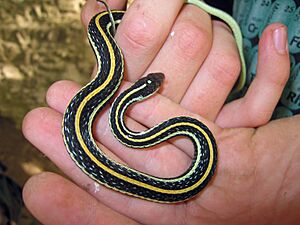Western ribbon snake facts for kids
Quick facts for kids Western ribbon snake |
|
|---|---|
 |
|
| Conservation status | |
| Scientific classification | |
| Genus: |
Thamnophis
|
| Species: |
proximus
|
| Synonyms | |
|
|
The Western Ribbon Snake, also called Thamnophis proximus, is a type of garter snake. These snakes are known for their long, slender bodies. You can find them in the central and southern United States. They also live in Mexico and Central America, reaching as far south as Costa Rica. There are six different kinds, or subspecies, of this snake.
About the Western Ribbon Snake
The Western Ribbon Snake is a thin snake with a very long tail. Its tail makes up about one-third of its total body length. The top of the snake's body is usually black, brown, or olive green. It has three light-colored stripes running along its back.
The underside of the snake is a greenish-white or yellowish-white color. The scales around its mouth are white and plain. These white scales stand out against the darker colors on the top and sides of its head. Adult Western Ribbon Snakes can grow to be about 17 to 50 inches (43 to 127 cm) long. The name proximus means it looks very similar to another snake, Thamnophis saurita.
Different Kinds of Western Ribbon Snakes
There are six recognized subspecies of the Western Ribbon Snake. A subspecies is a group of animals within a species that has small differences. These differences might be in their looks or where they live.
Here are the different kinds:
- T. p. alpinus Rossman, 1963 – This is the Chiapas Highlands ribbon snake.
- T. p. diabolicus Rossman, 1963 – This one is called the arid land ribbon snake.
- T. p. orarius Rossman, 1963 – This is the Gulf Coast ribbon snake.
- T. p. proximus (Say, 1823) – This is the orangestripe ribbon snake or western ribbon snake.
- T. p. rubrilineatus Rossman, 1963 – This snake is known as the redstripe ribbon snake.
- T. p. rutiloris (Cope, 1885) – This is the Mexican ribbon snake.
Where They Live and What They Eat
The Western Ribbon Snake is a semi-aquatic snake. This means it spends time both on land and in the water. It lives in many different places, but always close to water. You can find these snakes from sea level up to almost 2,500 meters (8,200 feet) high.
These snakes are carnivores, meaning they eat other animals. Their diet includes small creatures like earthworms and crayfish. They also eat small vertebrates such as lizards, fish, and frogs. This includes tadpoles, which are baby frogs.


